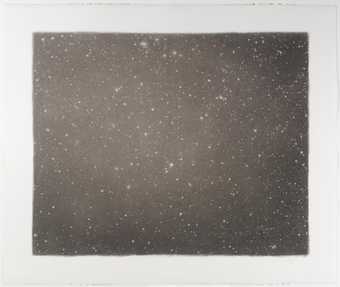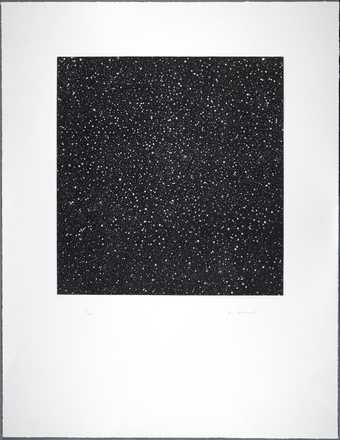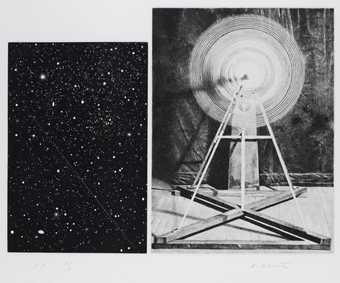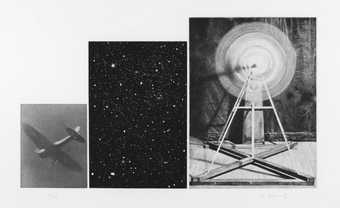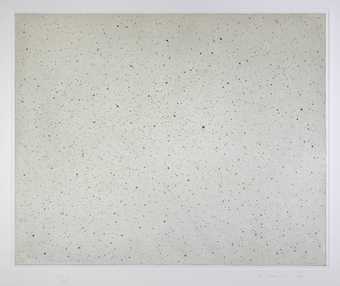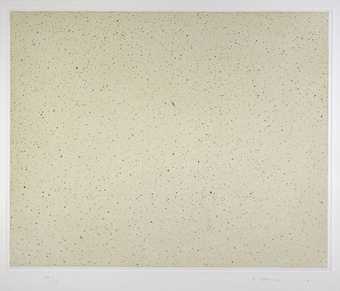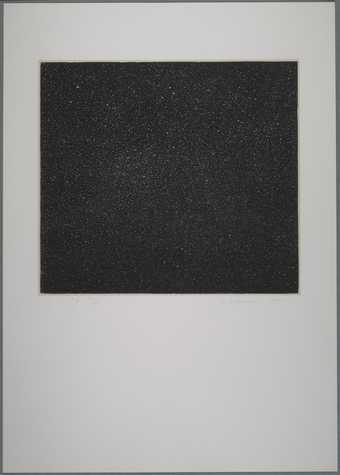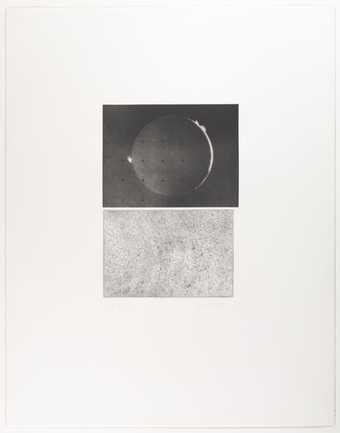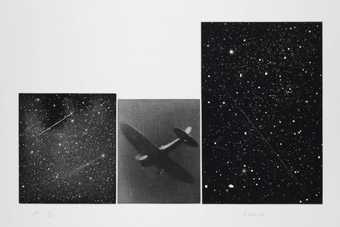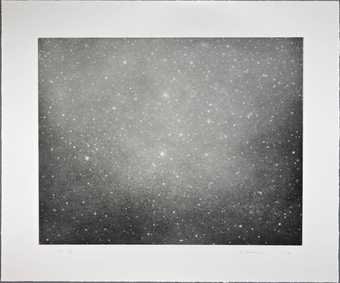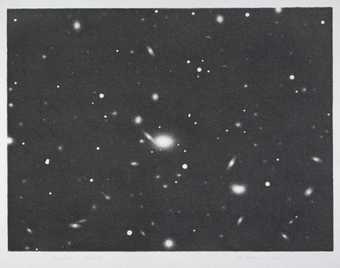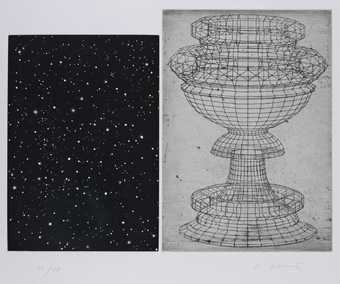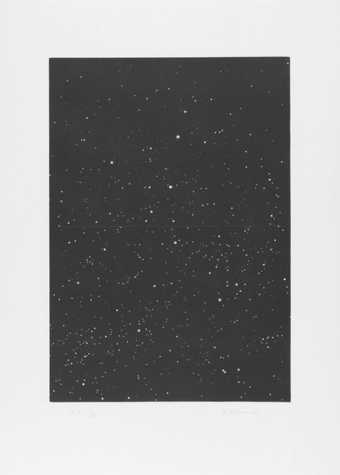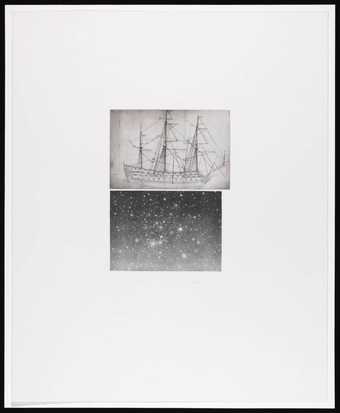
Not on display
- Artist
- Vija Celmins born 1938
- Medium
- Aquatint, drypoint and mezzotint on paper
- Dimensions
- Image (left): 125 × 110 mm
image (right): 119 × 94 mm
frame: 488 × 417 × 28 mm - Collection
- ARTIST ROOMS Tate and National Galleries of Scotland
- Acquisition
- ARTIST ROOMS Acquired jointly with the National Galleries of Scotland through The d'Offay Donation with assistance from the National Heritage Memorial Fund and the Art Fund 2008
- Reference
- AR00482
Summary
Concentric Bearings B is a two-colour print using aquatint, drypoint and mezzotint techniques on Rives BFK paper that brings together prints from two separate plates on a single sheet of paper. One print is an image of a starry night sky while the other shows a grainy image of a falling plane derived from a photograph clipping. It is the second of four prints, lettered A–D, that make up the Concentric Bearings series (Tate AR00469, AR00482, AR00483, AR00470). It was printed and published by Gemini G.E.L. (Graphic Editions Limited) in Los Angeles in an edition of thirty-five plus six artist’s proofs, in collaboration with master printmakers Kenneth Farley and Doris Simmelink. The copy held by ARTIST ROOMS is artist’s proof number 1/6, inscribed at the bottom left corner of the print, and signed by the artist at the bottom right in pencil.
The night sky image on the left is the slightly larger of the two portrait-oriented prints, and is based on a found photograph rather than direct observation of nature, as is the case with the majority of Vija Celmins’s drawings, prints and paintings. It has been printed using aquatint. The curator Susan Lambert has explained the basic premise of aquatint as ‘a method of etching in tone’ (Lambert 2001, p.60). Etching is an intaglio technique: an incised design where the print surface is sunk beneath the areas that are to remain blank. This print has a lively, textured surface. Looking closely, evidence of the drypoint’s linear engraving is visible. The drypoint needle, often used to retouch and refine an aquatint, here enhances the detailing of the variously shaped stars, whose pinpricks of light are in fact the un-inked white surface of the paper, which contrasts dramatically with the black ink of the space that surrounds them. Two shooting stars create a pair of diagonal lines across the sky that echoes the diagonal scratches on the falling plane print, which is a mezzotint. Susan Lambert describes the mezzotint technique, which Celmins has utilised in numerous prints, as ‘a form of tonal engraving and, because the engraver works from dark to light, it is often described as a negative process’ (ibid., p.50). The falling plane is an ominous symbol of warfare, which resonates with the artist’s childhood emigration from Latvia to the United States as a consequence of the Second World War. Falling planes first appeared in Celmins’s work in the mid-1960s at the height of the Vietnam War in a series of oil paintings that depicted Second World War-era German and American aircraft, such as Suspended Plane 1966 (San Francisco Museum of Modern Art).
Describing the Concentric Bearings series, curators Richard Field and Ruth Fine have stated: ‘In developing these prints, as she has developed all of the etchings, Celmins worked through many proof stages to achieve the precise tonalities she desired. In the course of proofing she was able to test the various combinations of images.’ (Field and Fine 1987, p.59.) Concentric Bearings B is the second print in this series of four works that collectively presents four separate plates (two different night sky prints, the grainy image of a falling plane, and a photogravure of the artist Marcel Duchamp’s (1887–1968) Rotary Glass Plates (Precision Optics) 1920) in different configurations so that no one print contains all images from the series. Prints A and B contain two images each, while C and D have three images. A sequence of repetitions and juxtapositions occur over the series as a whole. Discussing the genesis of the Concentric Bearings series, Celmins has said:
A sort of theme was developing around describing space … about spirals, concentric circles, the plane spiralling down, the rotary device spinning, the stars turning: a similarity of events. And of course I always liked Duchamp’s piece and also the reproduction through which I found it. I though it was kind of humorous that Duchamp wasn’t going to call his object art, so I put it in something that maybe you would call my art. It’s those little nuances that hold the work together.
(Quoted in Rippner 2002, pp.34–5.)
In Concentric Bearings B the two images are small relative to their paper support, which is a large, portrait-oriented sheet. There is more blank paper beneath the plates than above, and the prints appear to float against this large expanse of bare white paper, positioned close together and aligned along their bottom edges. As part of a series of prints that investigates spatial relations, this proportionality is purposeful. The artist has commented on this aspect of her printmaking practice, explaining:
The paper became an extension of the print. How the print sat on the paper and the peculiar proportion and placement all became the work … My feeling is that every decision about the size of the borders has a corresponding effect on how one perceives the image.
(Quoted in ibid., p.15.)
Further reading
Richard S. Field and Ruth E. Fine, A Graphic Muse: Prints by Contemporary American Women, exhibition catalogue, Mount Holyoke College Art Museum, South Hadley, Massachusetts 1987, reproduced p.62.
Susan Lambert, Prints: Art and Techniques, London 2001.
Samantha Rippner, The Prints of Vija Celmins, exhibition catalogue, Metropolitan Museum of Art, New York 2002, reproduced p.26.
Stephanie Straine
July 2010
Does this text contain inaccurate information or language that you feel we should improve or change? We would like to hear from you.
Online caption
Celmins began experimenting with double-image prints following such double-image drawings as 'Untitled (Desert-Galaxy) 1974', also in the ARTIST ROOMS Collection. Celmins combined images from photographs she had collected which were particularly significant to her. The 'Concentric Bearings' prints form an important series which Celmins produced with the Gemini G. E. L. print workshop in Los Angeles. The series explores different images of 'turning space'. Concentric Bearings B contains an image of a falling plane placed next to Celmins's image of stars turning in the night sky. The image of the plane was particularly poignant for Celmins who spent her childhood in Latvia and Germany in the late 1930s and 1940s.
Explore
- emotions, concepts and ideas(16,416)
-
- formal qualities(12,454)
-
- photographic(4,673)
- transport: air(271)
You might like
-
Vija Celmins Night Sky #19
1998 -
Vija Celmins December 1984
1985 -
Vija Celmins Concentric Bearings A
1984 -
Vija Celmins Concentric Bearings D
1985 -
Vija Celmins Mount Holyoke
1987 -
Vija Celmins Night Sky 1 Reversed
2002 -
Vija Celmins Night Sky 2 Reversed
2002 -
Vija Celmins Night Sky Woodcut
1997 -
Vija Celmins Jupiter Moon - Constellation
1983 -
Vija Celmins Concentric Bearings C
1984 -
Vija Celmins Night Sky 3
2002 -
Vija Celmins Untitled Portfolio: Galaxy
1975 -
Vija Celmins Constellation - Uccello
1983 -
Vija Celmins Divided Night Sky
2010 -
Vija Celmins Alliance
1983

